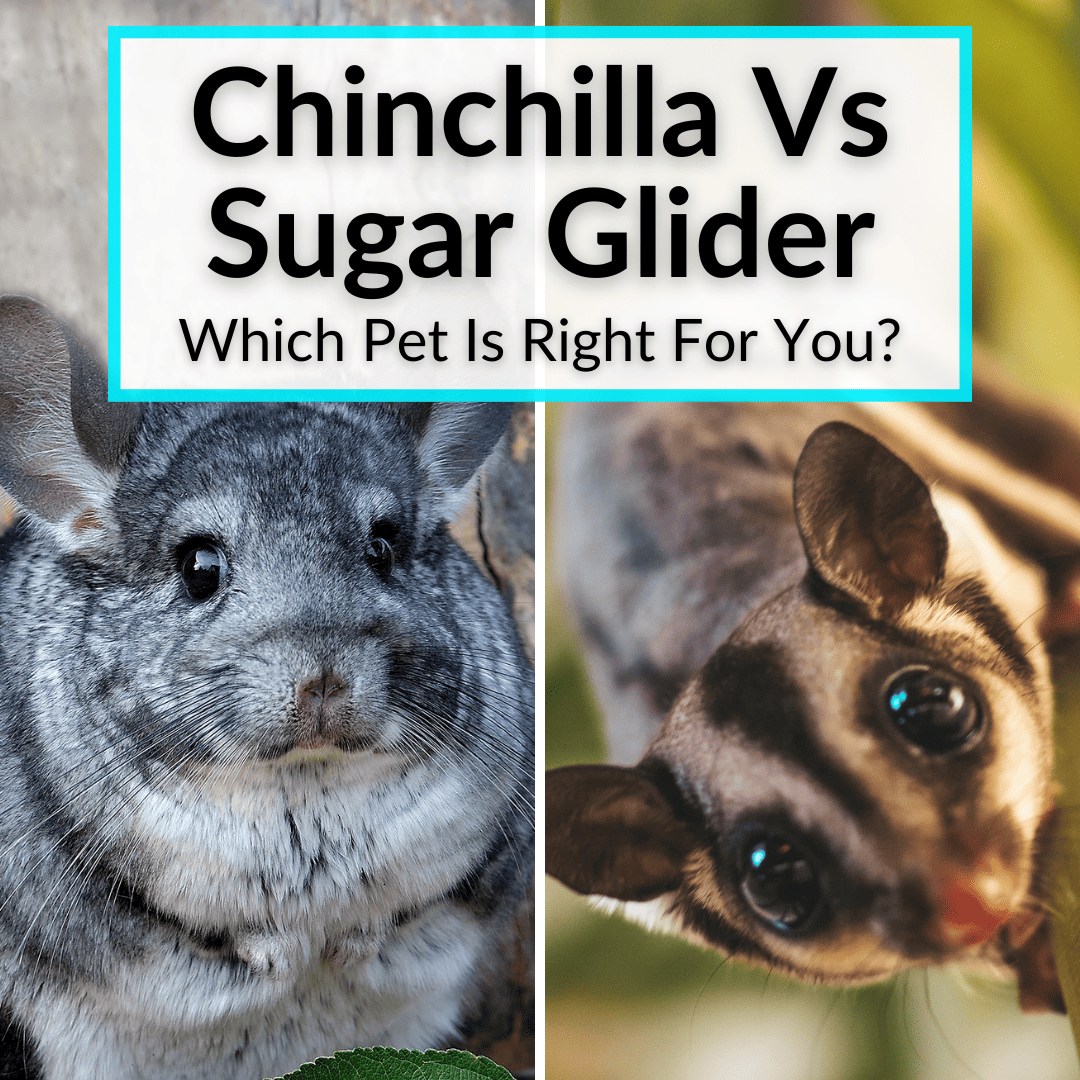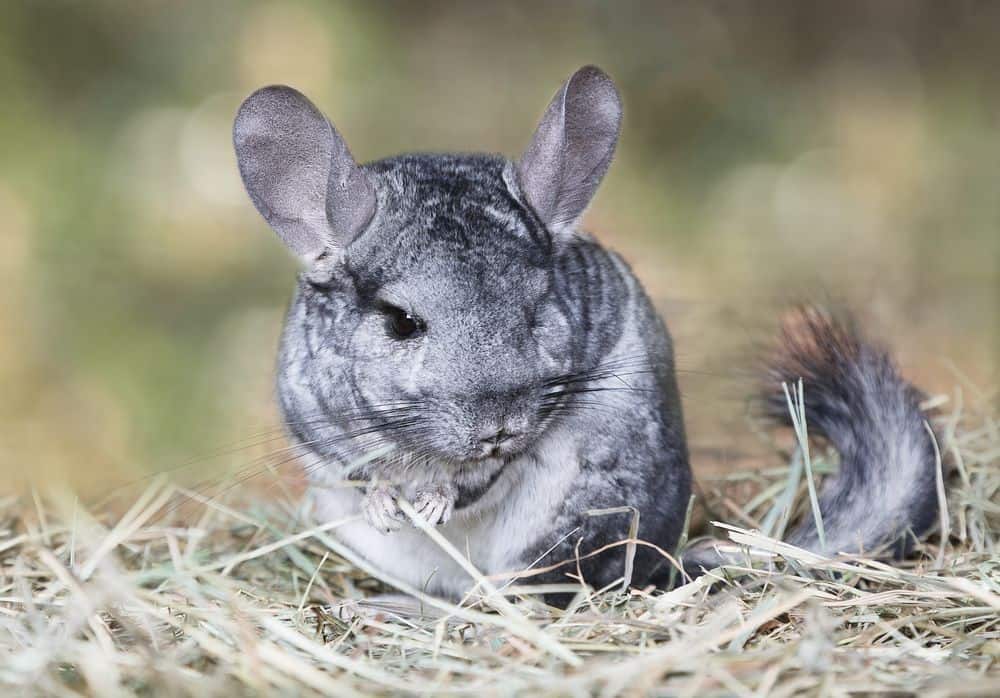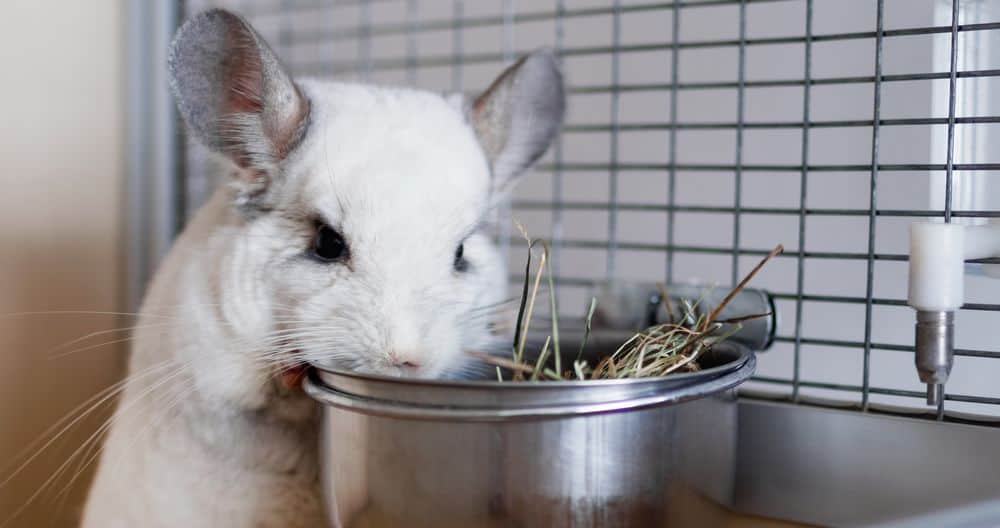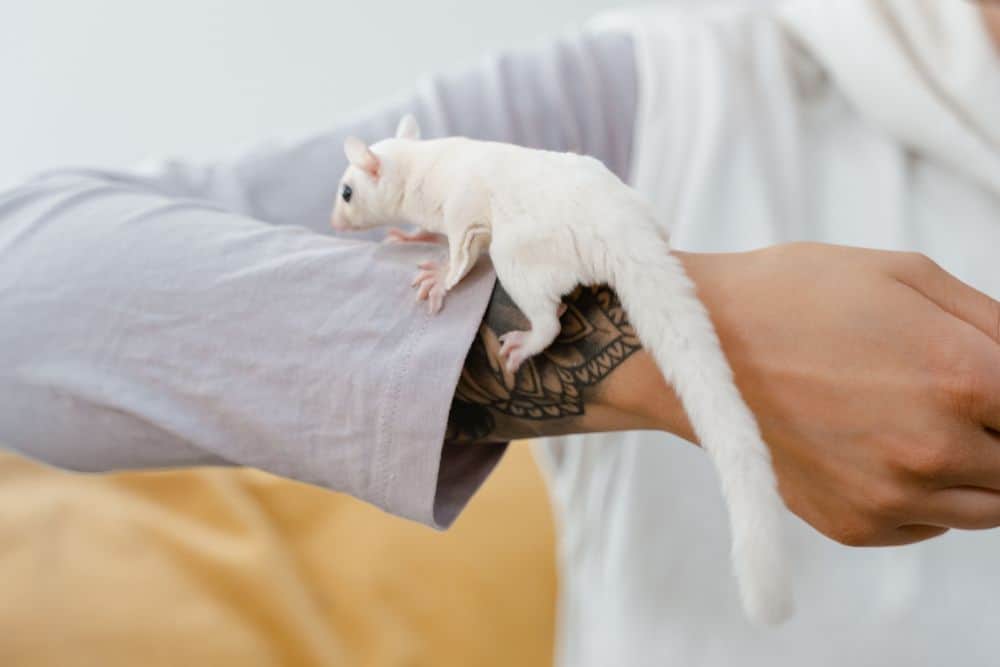
They are the softest, most adorable little creatures ever.
But when I first saw a sugar glider, I knew the chinchilla had some competition.
So I started doing some research.
I compared the chinchilla vs sugar glider and learned they have some similarities.
But also far more differences. And those differences are key. They determine which is the better pet for you.
For me it was definitely the chinchilla. For you it may not be. Keep reading to learn all about the sugar glider and how it compares to the chinchilla. By the end, you should have a good idea which one is right for you.
Contents
- 1 Chinchilla Vs Sugar Glider
- 2 Sugar Glider Vs Chinchilla: Final Thoughts
Chinchilla Vs Sugar Glider
We will begin our comparison of the sugar glider vs chinchilla by looking at each animal individually, before comparing them directly. We will finish with the advantages of each, to help you decide which is the right pet for you.
The Chinchilla

Chinchillas are small, furry rodents that make excellent pets. They are home to the South American Andes, but many breeders have started breeding them in the United States and Europe.
Chinchillas are known for their thick, soft, and furry coats. They have the thickest and softest fur among land animals.
The average chinchilla measures 9 to 14 inches (or around 25 cm) long. Its tail measures another 5 inches (or around 11 cm long) or so.
Chinchillas are entertaining pets. They are social animals that need other chinchillas for companionship. They also require human interaction.
Chins (as they are fondly known) show crepuscular behavior and are most active after dusk and before dawn. They need a steady supply of hay, along with commercial pellets specially formulated for chinchillas.
The Sugar Glider

Sugar Gliders are popular domestic pet marsupials that are taken from their native habitats and sold around the world. They are mainly found in Indonesia, Tasmania, mainland Australia, and Papua New Guinea. They belong to the same order as kangaroos, opossums, Tasmanian devils, and wombats.
These small and lightweight animals weigh just 4 to 6 ounces, which is around 115 to 150 g. They have thick, soft, mink-like fur on their bodies, with black stripes running on the back. The tip of their tail is black.
Sugar gliders are nocturnal animals that hunt for insects and other small vertebrates after dark. They love the sweet sap of trees like eucalyptus, acacia, and gum tree species. In fact, sugar gliders get their name for their liking of sweet sap and their ability to glide from tree to tree.
Differences Between Chinchillas And Sugar Gliders
There are several important differences between chinchillas and sugar gliders.
Origins And Natural Habitat
Sugar gliders are arboreal (tree-dwelling) marsupials found in Australia, Tasmania, and Indonesia. Chinchillas are rodents native to the dry, arid regions of the South American Andes.
Physical Differences
Chinchillas are larger and heavier than sugar gliders. They weigh, on average, between 1 and 3 lbs (16 to 48 ounces). Gliders weigh about 4 to 6 ounces.
Chinchillas have large, round ears and eyes. Sugar gliders are known for their large, expressive eyes, which help them see better in the dark.

Chinchillas have soft, dense fur, with colors ranging from gray, to white, to ebony, to beige, to brown, to more. Gliders also have several color variations, but gray is the most common.
Odor
Healthy and well-groomed chinchillas are odor-free and smell clean. Sugar gliders, when fed the right diet, have a sweet smell. One of the reasons they are named sugar gliders is because of their sweet smell.
Space Requirements
Chinchillas need a cage size of at least 24 by 24 inches for a single chinchilla. Sugar gliders need large, vertical cages with plenty of room to climb, fly, and glide. A single glider will need a cage that measures at least 20 by 20 by 30 inches.
Noise Levels
Chinchillas are relatively quiet animals compared to sugar gliders. They are active at night and may make some scurrying sounds. They also make chattering, cooing, whistling, squeaking, and teeth-grinding noises when they need something or are stressed.
Sugar gliders can be quite vocal and tend to bark loudly. If you have several sugar gliders, be prepared to be awakened at night by their loud barks and hissing.
Lifespan
Chinchillas have a lifespan of about 10 to 15 years, and some captive chinchillas have even lived for 20 years. Sugar gliders have a lifespan of 10 to 12 years.
Babies
Sugar glider babies are called Joeys. They spend several weeks in their mommy’s pouch. Chinchilla babies are called kits and can walk on their own within an hour of birth.
Diet

The Association of Sugar Glider Veterinarians recommends a diet of 75% pellets (specially formulated for gliders), 25% fresh fruits and vegetables, and tree nuts. Gliders are omnivores and often need a special diet, including tree sap, which may be hard to procure in some countries. This can cause malnutrition in these pets.
Chinchillas are mainly herbivores and need a constant supply of good-quality hay or grass, along with pelleted food made especially for chinchillas. The chinchilla diet may be easier to procure in most countries.
As Pets
There may be some legal considerations related to keeping sugar gliders as pets. For example, it is illegal to keep them as pets in states like California, Pennsylvania, Hawaii, and Alaska. Chinchillas are legal to own as pets in all the states of the USA.
Cost
Sugar gliders are expensive because of their rarity. In the United States, a single glider can cost between $200 and $500. Chinchillas are relatively inexpensive and easily available. They cost around $100 per chinchilla, when you buy one from a reputable breeder.
Grooming And Hygiene
Both animals are low-maintenance when it comes to grooming. However, chinchillas do need special dust baths a few times per week to eliminate oil, parasites, and dirt from their coats. Gliders do not need shampoo or water baths, nor do they need dust baths.
Health Issues
Chinchillas usually suffer from health issues like dental problems, respiratory issues, and gastrointestinal diseases. Sugar gliders, on the other hand, are known to suffer from issues like metabolic disease, dental issues, and malnutrition.
Similarities Between Sugar Gliders And Chinchillas

There are also a number of similarities between these two animals.
Hygiene
Both small pets need clean cages. A dirty cage can stress them out. Deep clean your pet’s cage every fortnight and also spot clean daily to prevent diseases and stress in your buddies.
Exercise And Enrichment
Both sugar gliders and chinchillas need plenty of physical activity and mental stimulation. As mentioned above, both their cages should be vertically spacious so they can jump, run, glide, and climb. Add plenty of perches, branches, hammocks, climbing ramps, tunnels, hideouts, etc. to their cages.
Provide both pets with an hour or two daily of out-of-cage time, but make sure to remove all hazards from the area and supervise your pet throughout the duration.
Socialization
Chinchillas and sugar gliders both need socialization and interaction with their own kind. In the wild, they live in groups or families, so it is best to house both animals in pairs or, better yet, groups of three or four. Similarly, both critters need human interaction and daily enrichment. Both animals can be trained with patience and consistency.
Advantages Of Chinchillas And Reasons To Get Them As Pets
Here are some reasons to get chinchillas as pets:
- Chinchillas are low-maintenance pets. They are ideal for beginners, adults, and kids alike. Chinchillas make affectionate pets, and they are also trainable. They are entertaining animals with cute behaviors and habits that are fun to watch.
- They have the softest fur, which does not shed dander. This makes them relatively hypoallergenic.
- Their life span is longer than that of sugar gliders.
- The chinchilla diet is easier to procure in most countries.
- Chinchillas aren’t as noisy as sugar gliders.
- They are fastidious self-groomers and keep their fur clean with dust baths and licking.
- Healthy, well-socialized, captive-bred chinchillas are rarely aggressive toward humans.
Advantages Of Sugar Gliders And Reasons To Get Them As Pets

- Sugar gliders are cute, unique, and exotic pocket pets that are sure to be conversation starters at your parties. They smell sweet and have adorable, expressive eyes. Their ability to glide is sure to amaze your visitors!
- Baby sugar gliders are not only cute to look at. They also have unique and interesting behaviors. They spend several weeks in their mommy’s pouch.
- Captive-bred sugar gliders easily bond with humans and other pets, including dogs and cats. They are highly trainable, too.
- Sugar gliders are hypoallergenic and ideal for people with allergies.
Sugar Glider Vs Chinchilla: Final Thoughts
The sugar glider vs chinchilla debate has a clear winner. But which one is the winner will differ for everyone. For me it is the chinchilla. It is the right pet for me.
How about for you? Do you now have a good idea which pet is better for you? Is it also the chinchilla, or would you be better suited with a sugar glider? Or maybe even both?
Leave a Reply